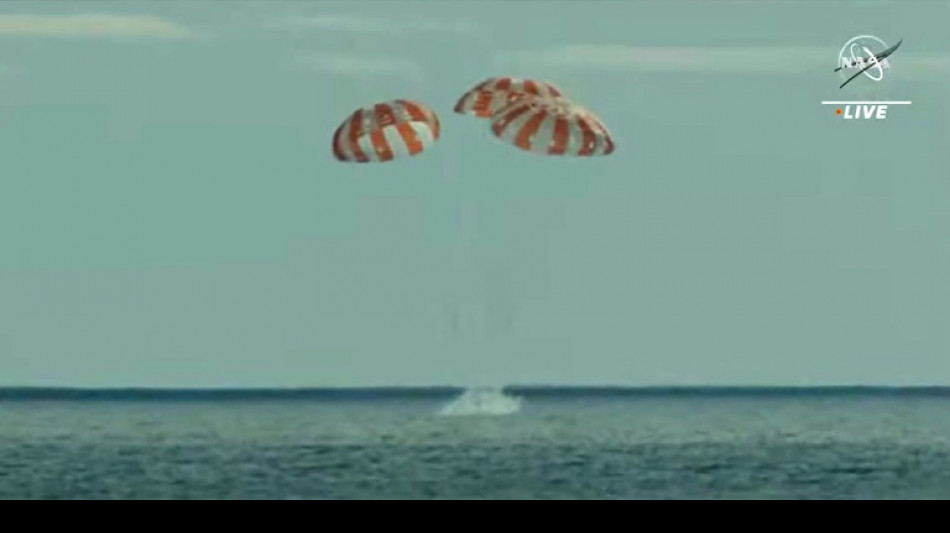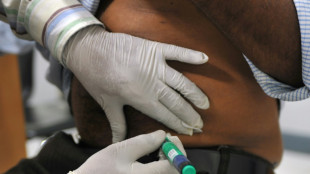
-
 Trump fills out cabinet as divisive picks shock Washington
Trump fills out cabinet as divisive picks shock Washington
-
Son hits 50th South Korea goal in win, Australia-Saudi stalemate

-
 BHP, Vale cleared by Brazil court over 2015 dam disaster
BHP, Vale cleared by Brazil court over 2015 dam disaster
-
Satirical US outlet The Onion buys conspiracy site Infowars

-
 Scotland must emulate Croatia's 'conveyor belt of talent': Clarke
Scotland must emulate Croatia's 'conveyor belt of talent': Clarke
-
Legal migration to OECD reaches new record in 2023

-
 Robinson edges Benazzi to succeed Beaumont as head of World Rugby
Robinson edges Benazzi to succeed Beaumont as head of World Rugby
-
India's capital shuts all primary schools due to smog

-
 Central bank independence 'fundamental' for good policy: Fed official
Central bank independence 'fundamental' for good policy: Fed official
-
Fritz beats De Minaur to eye ATP Finals last four, Sinner through

-
 Doris expecting a 'proper test' against Argentina
Doris expecting a 'proper test' against Argentina
-
Russia's exiled opposition hopes for rebirth with Berlin rally

-
 EU fines Meta $840 million for 'abusive' Facebook ad practices
EU fines Meta $840 million for 'abusive' Facebook ad practices
-
Springboks boss Erasmus expects England to 'play for Borthwick'

-
 Before Leicester, Ranieri's brush with glory with his beloved Roma
Before Leicester, Ranieri's brush with glory with his beloved Roma
-
Stock markets rise as traders weigh future Fed cuts

-
 Australian Robinson edges Benazzi to head World Rugby
Australian Robinson edges Benazzi to head World Rugby
-
US director Haynes to lead Berlinale 2025 jury

-
 Iran tells UN nuclear chief willing to resolve 'ambiguities'
Iran tells UN nuclear chief willing to resolve 'ambiguities'
-
Coach owner Tapestry calls off Capri bid on regulatory blocks

-
 UK government announces ban on new coal mines
UK government announces ban on new coal mines
-
US ski star Lindsey Vonn, 40, to attempt competitive return

-
 Ranieri comes out of retirement to lead hometown club Roma
Ranieri comes out of retirement to lead hometown club Roma
-
England recall Steward and Van Poortvliet for South Africa Test

-
 EU fines Meta 798 mn euros for Facebook ad antitrust breach
EU fines Meta 798 mn euros for Facebook ad antitrust breach
-
Australian Brett Robinson graduates to rugby's top post

-
 Brazil looking for motive after attempted Supreme Court bombing
Brazil looking for motive after attempted Supreme Court bombing
-
Hotels on Booking.com can offer better rates elsewhere: EU

-
 EU deforestation ban in chaos as parliament loosens rules
EU deforestation ban in chaos as parliament loosens rules
-
Springboks make 12 changes to team for England clash

-
 All Blacks fly-half Barrett returns from concussion against France
All Blacks fly-half Barrett returns from concussion against France
-
UEFA launches investigation into Premier League referee Coote

-
 Monaco Formula One GP extended until 2031
Monaco Formula One GP extended until 2031
-
Climate finance: who is being asked to pay what at COP29?

-
 'Terrible' AI has given tech an existential headache: activist
'Terrible' AI has given tech an existential headache: activist
-
COP29 host tries to calm waters after diplomatic turmoil

-
 Late drama as Saudis hold Australia in World Cup qualifier
Late drama as Saudis hold Australia in World Cup qualifier
-
Stock markets diverge as traders weigh future Fed cuts

-
 Israel warfare methods 'consistent with genocide': UN committee
Israel warfare methods 'consistent with genocide': UN committee
-
'In-form leader' Fickou starts for France against New Zealand

-
 Iran activist kills himself after demanding release of prisoners
Iran activist kills himself after demanding release of prisoners
-
Russia shuts Moscow's famed gulag museum

-
 London mayor says Trump attacks due to his ethnicity and religion
London mayor says Trump attacks due to his ethnicity and religion
-
Japan expect tough Indonesia test with World Cup spot in reach

-
 Uganda TikToker convicted for insulting president
Uganda TikToker convicted for insulting president
-
Thousands flee as Typhoon Usagi hits north Philippines

-
 Burberry launches turnaround plan as posts loss
Burberry launches turnaround plan as posts loss
-
Fickou starts for France against New Zealand

-
 Spain flood epicentre survives fresh rain alert
Spain flood epicentre survives fresh rain alert
-
Man with explosives dies in blast at Brazil's Supreme Court

| SCS | -0.26% | 13.335 | $ | |
| BCC | -1.14% | 140.94 | $ | |
| JRI | 0.04% | 13.245 | $ | |
| CMSC | 0.06% | 24.625 | $ | |
| BCE | 0.52% | 27.351 | $ | |
| RIO | -0.27% | 60.455 | $ | |
| CMSD | 0.1% | 24.755 | $ | |
| GSK | 0.48% | 35.28 | $ | |
| BTI | 0.58% | 35.625 | $ | |
| RYCEF | -2.16% | 6.96 | $ | |
| NGG | 0.8% | 62.62 | $ | |
| AZN | 0.91% | 65.89 | $ | |
| RBGPF | -1.59% | 59.25 | $ | |
| VOD | 0.4% | 8.785 | $ | |
| RELX | 0.51% | 46.355 | $ | |
| BP | 1.17% | 28.909 | $ |

NASA capsule Orion splashes down after record-setting lunar voyage
NASA's Orion space capsule splashed down safely in the Pacific on Sunday, completing the Artemis 1 mission -- a more than 25-day journey around the Moon with an eye to returning humans there in just a few years.
After racing through the Earth's atmosphere at a speed of 40,000 kilometers per hour (25,000 mph), the uncrewed capsule floated down to the sea with the help of three large red and white parachutes, as seen on NASA TV.
After a few hours of tests, the vessel will be recovered by a US Navy ship in waters off the coast of Mexico's Baja California.
The capsule shaped like a gumdrop had to withstand a temperature 2,800 degrees Centigrade (5,000 Fahrenheit) -- about half that of the surface of the sun -- as it entered the Earth's atmosphere.
The main goal of this mission was to test Orion's heat shield -- for the day when it is humans and not test mannequins riding inside.
Achieving success in this mission was key for NASA, which has invested tens of billions of dollars in the Artemis program due to take people back to the Moon and prepare for an onward trip, someday, to Mars.
A first test of the capsule was carried out in 2014 but that time it stayed in Earth's orbit, coming back into the atmosphere at a slower speed of around 20,000 miles per hour.
- Choppers, divers and boats -
The USS Portland was positioned to recover the Orion capsule in an exercise NASA has been rehearsing for years. Helicopters and inflatable boats were also deployed for this task.
The falling spacecraft eased to a speed of 20 miles (30 kilometers) per hour as it finally hit the blue waters of the Pacific.
NASA will now let Orion float for two hours -- a lot longer than if astronauts were inside -- so as to collect data.
"We'll see how the heat soaks back into the crew module and how that affects the temperature inside," Jim Geffre, NASA's Orion vehicle integration manager, said last week.
Divers will then attach cables to hoist Orion onto the USS Portland, which is an amphibious transport dock vessel, the rear of which will be partly submerged. This water will be pumped out slowly so the spacecraft can rest on a platform designed to hold it.
This should all take about four to six hours after splashdown.
The Navy ship will then head for San Diego, California where the spacecraft will be unloaded a few days later.
Upon returning to Earth, the spacecraft has traveled 1.4 million miles since it took off November 16 with the help of a monstrous rocket called SLS.
At its nearest point to the Moon it flew less than 80 miles (130 kilometers) from the surface. And it broke the distance record for a habitable capsule, venturing 268,000 miles (432,000 kilometers) from our planet.
- Artemis 2 and 3 -
Recovering the spacecraft will allow NASA to gather data that is crucial for future missions.
This includes information on the condition of the vessel after its flight, data from monitors that measure acceleration and vibration, and the performance of a special vest put on a mannequin in the capsule to test how to protect people from radiation while flying through space.
Some capsule components should be good for reuse in the Artemis 2 mission, already in advanced stages of planning.
This next mission planned for 2024 will take a crew toward the Moon but still without landing on it. NASA is expected to name the astronauts selected soon.
Artemis 3, scheduled for 2025, will see a spacecraft land for the first time on the south pole of the Moon, which features water in the form of ice.
Only 12 people -- all of them white men -- have set foot on the Moon. They did this during the Apollo missions, the last of which was in 1972.
Artemis is scheduled to send a woman and a person of color to the Moon for the first time.
NASA's goal is to establish a lasting human presence on the Moon, through a base on its surface and a space station circling around it. Having people learn to live on the Moon should help engineers develop technologies for a years-long trip to Mars, maybe in the late 2030s.
Ch.Havering--AMWN



